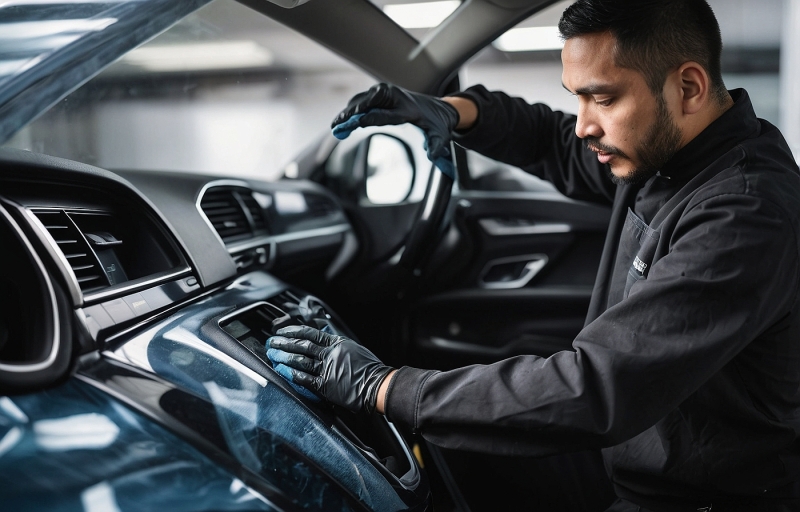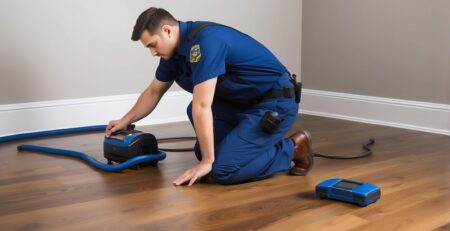Mold in Your Car: Causes and How to Remove It
Have you ever stepped into your car and noticed a musty, unpleasant smell? Mold in your car is more than just an annoyance—it can pose serious health risks and damage your vehicle’s interior. At [Kraus Restoration](https://krausrestoration.com/), we specialize in mold cleanup and restoration, ensuring a safe and clean environment for your car and home.
Mold thrives in damp, humid conditions, often caused by leaks, spills, or poor ventilation. Once it takes hold, it spreads quickly, leading to stains, odors, and potential respiratory issues. This article will explore the common causes of mold in your car and provide step-by-step solutions to remove it effectively.
Ignoring mold can lead to costly repairs and persistent health problems. But don’t worry—we’ve got expert-backed solutions to help you tackle the issue. Let’s dive into the best ways to eliminate mold and keep your car fresh and safe!
Understanding Mold in Your Car
Mold thrives in damp, humid environments, making your car an ideal breeding ground. It forms when moisture accumulates due to leaks, spills, or poor ventilation. Once present, it spreads quickly, attaching to seats, carpets, and air vents. Common types found in vehicles include Cladosporium, Aspergillus, and Stachybotrys, also known as black mold. Each type poses unique risks, with black mold being the most hazardous.
Exposure to mold can trigger serious health issues. Respiratory problems, allergies, and skin irritation are common symptoms. Prolonged exposure may lead to chronic conditions, especially for individuals with asthma or weakened immune systems. Mold spores circulate through the air, making it easy to inhale them unknowingly. Addressing the issue promptly is crucial to maintaining a safe driving environment.
If you suspect mold in your vehicle, professional removal is the best solution. Expert mold cleanup ensures thorough elimination, preventing regrowth. Additionally, addressing water damage with proper water cleanup helps eliminate moisture sources. For more details on effective restoration, explore our services.
Common Causes of Mold Growth in Cars
Excess moisture inside a vehicle creates the perfect environment for mold. Poor ventilation traps humidity, allowing spores to thrive. When windows remain closed for long periods, airflow becomes restricted, increasing condensation. This dampness seeps into seats, carpets, and other porous materials.
Spills and leaks also contribute to mold growth. Liquid from drinks, rainwater, or a faulty sunroof can soak into upholstery. If not dried quickly, moisture lingers and encourages fungal development. High humidity further accelerates the process, especially in warm climates. Vehicles parked in shaded or enclosed areas often retain moisture longer, worsening the issue.
Infrequent use of a car can also lead to mold problems. When a vehicle sits idle for weeks, stagnant air and trapped moisture create ideal conditions for spores to spread. Dust and organic debris inside the cabin provide additional nourishment for mold. Regular cleaning and proper ventilation help prevent these issues. If mold has already developed, professional mold cleanup services may be necessary. For expert assistance, visit our contact page today.
Signs That Your Car Has Mold
Dark spots or fuzzy patches on seats, carpets, and air vents indicate mold growth. These discolorations often appear green, black, or white, spreading quickly in damp conditions. If left untreated, they can damage your car’s interior and worsen over time.
A persistent musty odor is another clear sign. This damp, earthy smell lingers even after cleaning and becomes stronger in enclosed spaces. If you notice this scent, mold is likely present and spreading.
Mold exposure can trigger allergic reactions and respiratory issues. Symptoms include sneezing, coughing, itchy eyes, and difficulty breathing. Passengers with asthma or weakened immune systems may experience more severe effects. Addressing mold promptly helps maintain a safe environment.
If you suspect mold, professional mold cleanup is essential. Experts can assess the damage and restore your vehicle effectively. For more details on our services, visit our website. If you need assistance, feel free to contact us today.
How to Prevent Mold Growth in Your Car
Keeping your car dry is essential to prevent mold growth. Use moisture absorbers like silica gel or charcoal bags to reduce humidity. Park in well-ventilated areas whenever possible, and crack the windows slightly when it’s safe. Avoid leaving wet items inside, such as umbrellas or damp clothes, as they create the perfect environment for mold.
Regular cleaning and maintenance help keep mold at bay. Vacuum carpets and seats frequently to remove dirt and moisture. Wipe down surfaces with a disinfectant to eliminate any spores before they spread. Deep clean the interior periodically to prevent buildup. If you suspect mold, consider professional mold cleanup services for thorough removal.
Leaks can lead to serious mold issues if not addressed. Check for water stains or damp spots under the mats and around windows. Inspect the sunroof, door seals, and air conditioning system for leaks. Fix any issues immediately to prevent moisture buildup. If water damage occurs, professional water cleanup services can help restore your vehicle. For expert assistance, reach out through the contact page.
Step-by-Step Guide to Removing Mold from Your Car
To remove mold from your car, gather essential supplies. Wear gloves and a mask to protect yourself. Use a specialized mold cleaner, soft brushes, microfiber cloths, and a vacuum with a HEPA filter.
Start by vacuuming all affected areas to remove loose spores. For fabric seats and carpets, spray a mold remover and scrub gently. Wipe with a damp cloth and let it dry completely. Leather surfaces require a different approach. Use a mild cleaner and a soft brush to avoid damage. Wipe thoroughly and condition the leather afterward.
Mold can also spread through the ventilation system. Turn off the AC and remove cabin air filters. Clean vents with a disinfectant spray to eliminate spores. Replace the filter if necessary. Keeping your car dry prevents future mold growth.
If the infestation is severe, consider professional mold cleanup services. Regular maintenance and proper ventilation help keep your vehicle mold-free. For expert assistance, check out our services or contact us today.
Natural Remedies vs. Chemical Cleaners for Mold Removal
Natural solutions like vinegar and baking soda effectively remove mold without harsh chemicals. Vinegar’s acidity kills mold spores, while baking soda absorbs moisture and neutralizes odors. These options are safe for most surfaces and pose no health risks. However, they may require multiple applications for stubborn mold growth.
Commercial mold removers contain strong chemicals designed for deep cleaning. They work quickly and penetrate porous surfaces, making them ideal for severe infestations. However, they often release fumes that can cause respiratory irritation. Proper ventilation and protective gear are essential when using these products.
For light mold issues, natural remedies are a safer choice. They work well for routine maintenance and minor mold spots. In contrast, chemical cleaners are best for extensive mold problems or when natural methods fail. If mold persists, professional mold cleanup may be necessary.
When choosing a method, consider the severity of the mold and the surface type. Always test a small area before applying any solution. If unsure, consult a professional for expert advice.
How to Keep Your Car Mold-Free After Cleaning
Thoroughly drying your car after cleaning is crucial to prevent mold from returning. Open all doors and windows to allow proper ventilation. Use a fan or park the vehicle in direct sunlight to speed up the drying process. Pay extra attention to carpets, seats, and hidden corners where moisture can linger.
To keep humidity levels low, place moisture absorbers or a dehumidifier inside the car. Silica gel packs or activated charcoal work well in trapping excess moisture. Regularly check and replace them to maintain effectiveness. Avoid leaving wet items like umbrellas or towels inside, as they can create the perfect environment for mold growth.
Routine inspections help detect early signs of mold before it spreads. Check under seats, floor mats, and air vents for any dampness or musty odors. Keeping your car clean and well-maintained reduces the risk of future mold issues. If you notice persistent moisture problems, consider professional mold cleanup services. For expert assistance, explore our services or contact us today.
When to Seek Professional Help for Mold Removal
Severe mold infestations can spread deep into carpets, upholstery, and ventilation systems. If the affected area exceeds 10 square feet, DIY methods may not be enough. Mold exposure can trigger allergies, respiratory issues, and structural damage. When mold keeps returning despite repeated cleaning, professional intervention is necessary.
Experts use advanced equipment to detect hidden mold and ensure complete removal. They also address moisture issues to prevent future growth. Attempting to remove extensive mold without proper training can worsen contamination. Professionals follow industry standards to restore air quality and protect your health.
Choosing a reliable service is crucial. Look for certified specialists with experience in mold remediation. Check reviews and ask about their process before hiring. A reputable company should offer a thorough inspection and a clear remediation plan. For trusted services, visit our mold cleanup page.
If water damage caused the mold, addressing the source is essential. Our water cleanup experts can help prevent future outbreaks. For more details, explore our about page to learn about our expertise.
Frequently Asked Questions (FAQs)
Yes, mold in your car can make you sick. It can trigger allergies, respiratory issues, and other health problems. Mold grows within 24 to 48 hours in a damp environment. The best way to remove it from car seats is by using a mixture of white vinegar and baking soda. Avoid using bleach, as it can damage fabrics and release harmful fumes.
To prevent mold from returning, keep your car dry and well-ventilated. Regularly clean and inspect for moisture buildup. Driving a car with mold inside is unsafe, as it can affect air quality and cause health issues. Mold can also spread to your air conditioning system, leading to unpleasant odors and potential damage.
If your car smells musty but you don’t see mold, check hidden areas like under carpets and seats. Mold can cause permanent damage to your car’s interior if left untreated. Professional mold removal costs vary but typically range from $200 to $1,000. For expert mold cleanup, consider hiring professionals. Learn more about our services or contact us for assistance.










